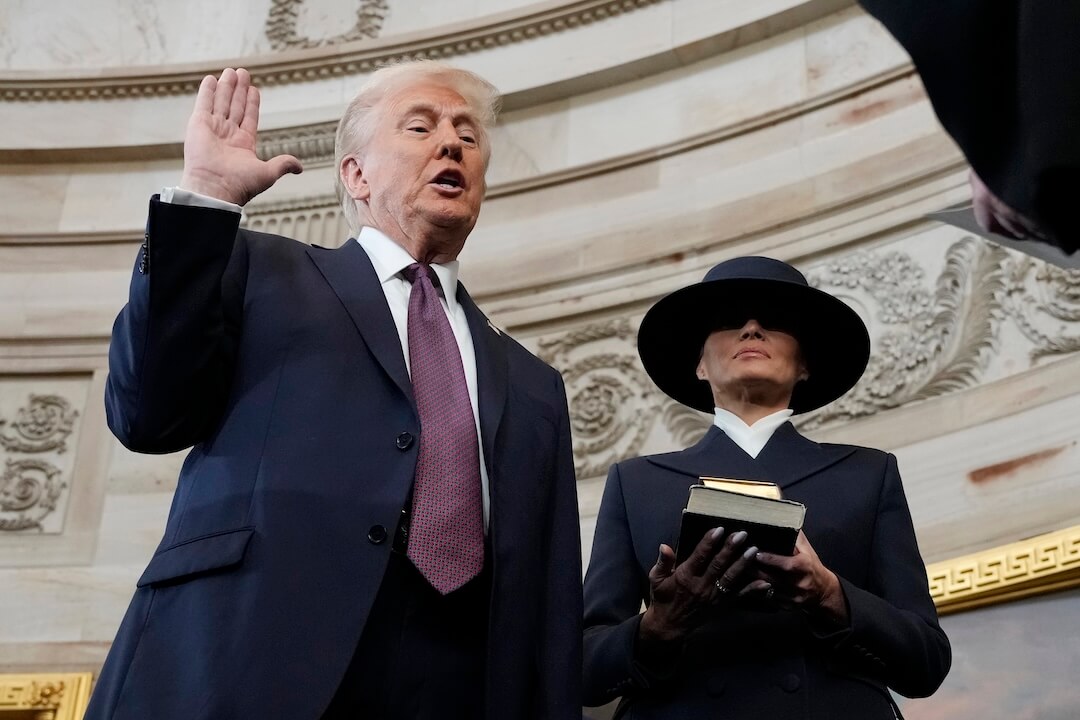Before he ever stepped foot in Iraq, Washington Post reporter Ed O’Keefe had already navigated his way through landmines, used a tourniquet to help an injured person, and been ambushed.
He did all this and more in a hostile environment training course that he took prior to a six-and-a-half week reporting stint in Iraq. The training, he said, helped prepare him for what to expect and made him more aware of the precautions he needed to take to stay safe.
“Was I using what I learned on a daily basis? No. But was I conscious of things I wouldn’t have otherwise known? Absolutely,” said O’Keefe, a congressional reporter who volunteered to go to Iraq. “There were nights when I walked through the Green Zone and was conscious of the fact that behind that corner, someone could be waiting, conscious that an explosive could go off at any point, conscious of not walking in the shadows, but in the light.”
The Washington Post — which strongly urged but didn’t require O’Keefe to take the course — is one of several news organizations that pays for its reporters to go through hostile environment training before entering a war zone. I talked with several journalists who have undergone the training, as well as two groups that run it — AKE and Centurion, both based in the U.K.
Using mock scenarios to prepare journalists
O’Keefe did his training through Centurion, which trains about 1,000 journalists from around the world each year. The organization runs two to three courses in the U.K. every month and one course in Virginia each month.
Centurion, which began training journalists in 1993 during the Bosnian War, regularly changes the training to better fit the current situations in war-torn areas. Business Development Manager Carole Rees said each course typically has up to 16 journalists who, upon completing the course, are awarded certificates that are valid for three years. Centurion offers a two-day follow-up program for those who want to get re-certified.
The organization’s most popular training course lasts five days and costs about $3,000 per person. Trainees learn a variety of skills — how to detect landmines, how to handle a check point and how to protect yourself from tear gas.
The training incorporates real-life, hands-on scenarios so participants get a better idea of what it’s like to be in some of the situations they learn about. One of the scenarios has instructors ambush journalists. They even put hoods over the journalists’ heads, and hold them up at gunpoint.
AKE, which trains journalists from news organizations such as CNN, the BBC and News International, also includes mock scenarios in its training. “We put them in the situations they learn about to see how they react,” said Nick Jordan, AKE’s head of training. “It’s all well and good seeing it on a PowerPoint, but we feel that it’s important to put them through these scenarios so they can learn 10 times more through actually doing it.”
San Antonio Express-News Military Reporter Sig Christenson, who attended Centurion training seven years ago, vividly remembers the mock scenarios. Even though he had been to Iraq three times prior to going through the training, he says he still wasn’t prepared for them.
“When my Centurion instructor put a gun to my head — a 9-millimeter — I forgot that it was a training session. Something about that gun to my head really set me off, and I was about to fight him, which would have been a mistake,” Christenson said by phone. “Part of what you’re taught is that you should not fight back. If you’re not careful, you’re going to get hurt or killed if you put up a lot of resistance.”
Christenson said the lessons he learned in his training have stayed with him. He still has his Centurion manual and handwritten notes from the course, which he referred to before going to Afghanistan in 2010.
The Miami Herald’s Carol Rosenberg, who attended the training in 2002, said by phone that she also found the mock scenarios helpful because they taught her to take a more studied and systematic approach to reporting in dangerous places. She still recalls one incident in which she was being driven to the training site, only to be derailed by a fake explosion.
“Suddenly, there are people who are insurgents who are taking you hostage quite briskly, and putting a hood on you. I know it was a gamed exercise, but it was uncomfortable and unsettling,” said Rosenberg, who has been to Iraq numerous times and now covers Guantanamo Bay. “It made me realize how little situational awareness you have. You really don’t know after the fact how to necessarily describe or recreate precisely how you found yourself in that situation.”
Medical emergency training resonates with trainees
Most of the journalists I talked with said the medical emergency training they received was the most helpful part of the course.
“I’ve put lessons in safe tactics from the course to good use in battlefield and patrol scenarios in Iraq, Afghanistan and Libya,” CNN International Anchor and Correspondent Michael Holmes said via email. “But, to me, the most important element of the course is medical training. I’ve had eight colleagues and friends killed in places like Iraq, Libya and Syria in recent years and I know how a little training can save lives.”
Christenson agreed, saying he learned lessons that could have saved his life, had he found himself in a serious medical situation. He learned, for instance, how to use a tourniquet and how to start a triage.
“You saw gaps in your knowledge which were significant enough to make a difference between surviving and not surviving,” he said. “That’s worth my time.”
Instructors who know journalists’ risks
The instructors in both AKE’s and Centurion’s programs are ex-military personnel who have been previously embedded with journalists.
The majority of Centurion’s instructors, Rees said, worked on NBC’s media security team for several years in Baghdad and were embedded with a variety of journalists in Iraq, including Tom Brokaw.
Rees described instructors’ relationship with trainees as a “two-way street.” “We want to learn from the people in the course about their experiences because it helps our instructors better understand the job they do,” she said by phone. “A lot of them keep in touch and tell us what situations they may have been in, and what tips they found most useful.”
The Post’s O’Keefe said that knowing the instructors had worked with journalists in the field made the training feel more specialized.
“The best part about the experience, and why there weren’t any sort of lingering issues in my mind, is that the instructors had been on the ground with journalists in war,” he said. “These were guys who were not only trained British Royal Marines but who understood the safety concerns and how to apply them in a journalistic situation.”
Still a strong demand for training
Even though many news organizations have had to close foreign bureaus, Centurion and AKE said participation among U.S. journalists has been steady. The number of news organizations sending journalists abroad dipped a bit after troops started to withdraw from the Iraq war, Rees said, but has picked back up again since the Arab Spring.
Centurion and AKE have both expanded their operations in recent years. AKE, which offers training in the U.K. and Atlanta, has also started to run courses at their clients’ locations, per request. Later this month, AKE is sending some of its instructors to New York City to work with CBC New York. It’s more challenging to do these training sessions, Jordan said, because the venues are not always conducive to mock scenarios.
Centurion used to train only in the UK, but opened a site in Virginia 10 years ago to accommodate a growing demand among U.S. news organizations. The organization just recently started offering training in Abu Dhabi and Qatar for journalists who are reporting there and can’t make it to the U.S. or the U.K. for training.
The Associated Press, Reuters and The Washington Post are among Centurion’s biggest clients, Rees said. Centurion just recently started training French journalists, and has seen an uptick in the number of journalists attending from Russia, Norway and Germany.
“Even though media companies are obviously making cutbacks in some areas, I don’t think they’re cutting back on health and safety training,” Rees said. “I don’t really think it’s an area they’re able to, or are willing to, backpedal on. There seems to be a much greater awareness than there once was of care toward journalists.”
Rees said that while news organizations usually send staffers to training, some have started sending stringers. Still, there are freelancers who can’t afford the training and who aren’t affiliated with a news organization that will send them. Such was the case with photographer Lynsey Addario, who was kidnapped last year in Libya along with three other journalists working for The New York Times.
“When I was starting to cover war in 2001, I couldn’t afford a hostile environment training course. I’ve been freelance my whole career, and was near poor for the first five or so years of it,” she said via email. “When I could finally afford the course, I had already gotten a lot of on the job (not necessarily welcome!) experience.”
Addario’s kidnapping, and the recent deaths of Anthony Shadid, Tim Hetherington, Chris Hondros, Marie Colvin, Remi Ochlik and others, has renewed attention to the dangers reporters and photographers face when in war zones.
Given how many journalists the industry has lost, some say there’s no question news organizations should pay for staffers to go through hostile environment training.
“It’s not only good practice in security and common sense, but I also think it helps your journalism because it makes you more conscious of your limitations,” O’Keefe said. “It at least sets off something in your brain that says, ‘Should I really do this? Is it worth the risk?’ No story is more valuable than your life.”








Comments